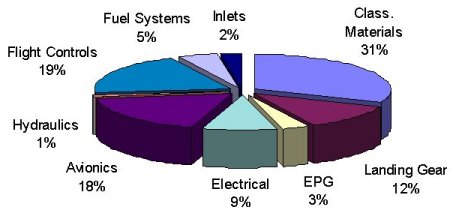|
||||||||||
|
|
||||||||||
|
||||||||||
|
|
||||||||||
|
|
|
|||||||||||||||||||||||||||||||||||||||||||||||||||||||||||||||
|
Avionics:Since the Storm Shadow is an unmanned aircraft, it will rely heavily on its onboard avionics systems. The most important advance in technology that makes this type of aircraft possible is the Global Positioning System (GPS). The aircraft uses differential GPS for its navigation to ensure reliable autonomous control. Because the aircraft is designed to operate independently of human control for the majority of its mission, a flight computer is also provided. Able to access the onboard integrated avionics system, center of gravity control computer, and fly-by-wire control system, the computer is able to maintain control of the aircraft at all times. The primary auxiliary systems carried aboard the aircraft are summarized below.
Auxiliary Systems Summary
The breakdown of avionics as part of the overall auxiliary systems weight is as follows:

Auxiliary systems weight breakdown
Product Descriptions:The Multi-Application Control Computer (MACC) can be monitored and controlled by a remote ground station and is capable of processing the inputs from 50,000 sensor sets. The MACC is currently used in aircraft for flight control, vehicle management system control, and actuator/subsystem control. The Modular Integrated Avionics Group/Navigation Sensor Unit (MIAG) is a vehicle management system with integrated local air data specifically designed for use in UAV's. The MIAG utilizes a DGPS receiver for pre-programmed aircraft navigation as well as general aircraft position data. In addition, several air data pressure transducers supply the flight computer with necessary airspeeds and altitudes. The unit also contains an engine command and control system as well as a payload management system for operating the bomb bay and bomb rack. The MIAG has a built in IFF (identification--friend or foe) system and a fiber optic inertial measurement unit (IMU) to assist in attitude and heading references. The Harris VHF Data Link and adaptive DGPS antenna were designed for military use in areas filled with hostile electronic environments. The antenna is the primary system used to feed date to the MIAG. The Ultra 6000 airborne imager provides final targeting, imaging, and man-in-loop flight control. The system uses a high resolution CCD camera with a 15:1 zoom and advanced focal plane array detector technology to deliver high resolution infrared images. The system is capable of detecting thermal differences of less than 0.03 degrees C and can penetrate darkness, fog, and foliage to identify people and targets. The entire system is self-cooled with a Sterling closed cycle cooler. To designate targets for the GBU-16 bomb, a laser designator is attached to the FLIR so that targets can be acquired independently. The FLIR is located in the nose of the aircraft giving it the ability to see below and in front of the aircraft. The avionics suite operates the control surfaces and thrust vectoring via an analog fly-by-wire system. The FBW used on the aircraft is the same as that used on the pre-block 40 F-16 Fighting Falcon fighter. To remain stable in flight, fuel must be drawn equally from each of the tanks aboard the aircraft. The Center of Gravity Computer is included for this purpose since it assists the FBW in maintaining smooth, stable flight. The AN/APR-50 electronic warfare system is currently used on the B-2 Spirit. The system is capable of covering the lower frequencies and up to Band 4 from 500 MHz to 1 GHz. Otherwise, very little information is available on this highly classified system. During payload release, a human pilot will take control of the aircraft from a ground station. Most UAV programs currently employ ground stations to input pre-programmed navigation controls and to control the aircraft when necessary. The ground station for the Storm Shadow consists of VHF transmitters and receivers as well as hardwire connectivity with the TROJAN SPIRIT II satellite communications terminal for over-the-horizon communications. The station is manned by two: a pilot with access to all necessary flight information and a payload officer responsible for releasing the weapon. A "backpack" version of the station, operated by a pilot/payload officer in a forward deployed situation, is also possible. |


|
Aircraft | Design | Ask Us | Shop | Search |

|
|
| About Us | Contact Us | Copyright © 1997- | |||
|
|
|||